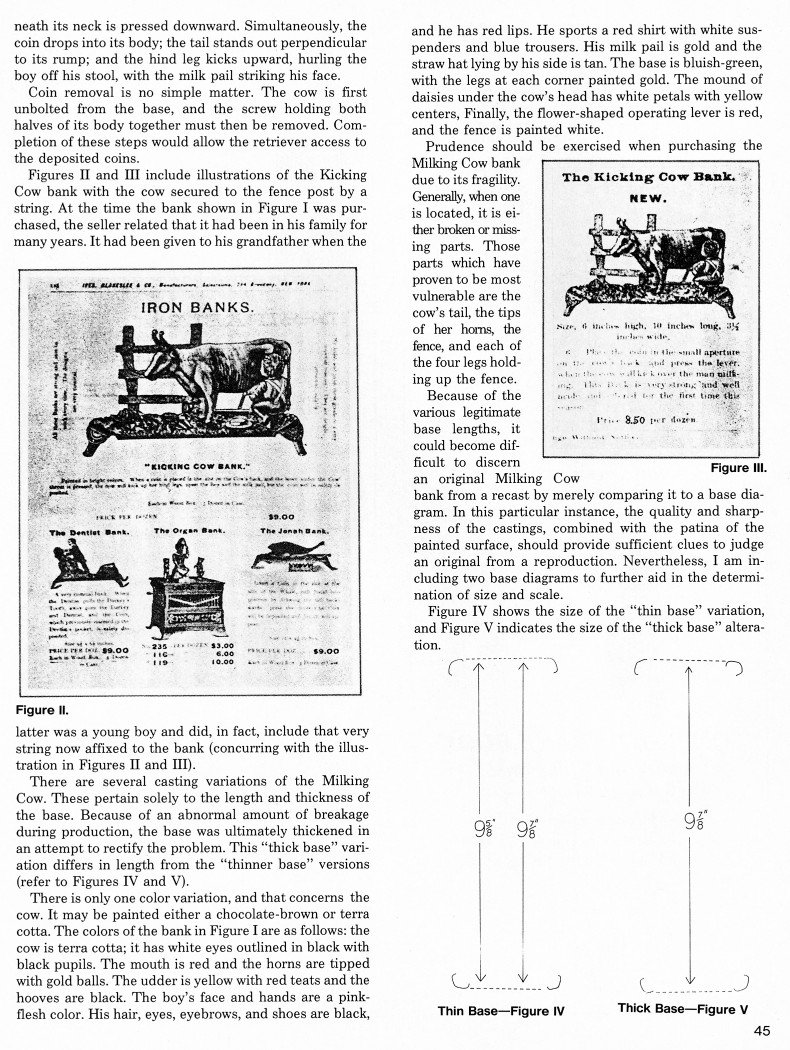|
The Milking Cow Bank
(The Kicking Cow Bank)
by Sy Schreckinger – ANTIQUE TOY WORLD Magazine – August, 1987
Humiliating
situations involving specific ethnic and racial groups provided a fertile
area for nineteenth-century mechanical bank designers. The Milking Cow
bank (Figure I) would seem to deviate from this, since the subject of
ridicule is a Caucasian farm boy. However, closer inspection of a bank
which appears devoid of any racist intent reveals an uncanny resemblance
between the farm boy's face and attitude and those of both Negro men
portrayed in the J. and E. Stevens' "Dentist" and "Bad Accident" banks.
To date, patent information relating to the production and design of
the Milking Cow bank is sadly lacking. If, however, the Stevens Company
was the manufacturer (as indicated by the research of others over the
years), it is curious that a company which was engaged in producing many
mechanical banks reflecting racist themes would paint a figure white when
it was, in all likelihood, designed to be black.
To further support the belief that J. and E. Stevens may have
manufactured this mechanical, specific elements such as an abundance of
leaf and floral designs integrated within the Milking Cow's base reflect
the unmistakable trademark of the well-known mechanical bank designer,
Charles Bailey. The Stevens Company employed Bailey during the same period
of time in which the Milking Cow bank was marketed.
All early advertisements of the Milking Cow bank refer to it as the
"Kicking Cow" bank. Figures II and III illustrate this in advertisements
from wholesale toy catalogs circa 1880. Figure II represents a catalog
page from Ives, Blakeslee and Company, which offered the "Kicking Cow" for
$9.00 per dozen, while its competitor, Selchow and Richter, priced the
bank at $8.50 per dozen!! It is uncertain when and why collectors began
referring to the "Kicking Cow" as the "Milking Cow" bank.
"Animated" and "slapstick" are descriptions befitting the action of
the "Milking Cow." After placing a coin into a slot in the cow's back, the
red, flower-shaped lever beneath its neck is pressed downward.
Simultaneously, the coin drops into its body; the tail stands out
perpendicular to its rump; and the hind leg kicks upward, hurling the boy
off his stool, with the milk pail striking his face.
Coin removal is no simple matter. The cow is first unbolted from the
base, and the screw holding both halves of its body together must then be
removed. Completion of these steps would allow the retriever access to the
deposited coins.
Figures II and III include illustrations of the Kicking Cow bank with
the cow secured to the fence post by a string. At the time the bank shown
in Figure I was purchased, the seller related that it had been in his
family for many years. It had been given to his grandfather when the
latter was a young boy and did, in fact, include that very string now
affixed to the bank (concurring with the illustration in Figures II and
III).
There are several casting variations of the Milking Cow. These
pertain solely to the length and thickness of the base. Because of an
abnormal amount of breakage during production, the base was ultimately
thickened in an attempt to rectify the problem. This "thick base"
variation differs in length from the "thinner base" versions (refer to
Figures IV and V).
There is only one color variation, and that concerns the cow. It may
be painted either a chocolate-brown or terra cotta. The colors of the bank
in Figure I are as follows: the cow is terra cotta; it has white eyes
outlined in black with black pupils. The mouth is red and the horns are
tipped with gold balls. The udder is yellow with red teats and the hooves
are black. The boy's face and hands are a pink-flesh color. His hair,
eyes, eyebrows, and shoes are black, and he has red lips. He sports a red
shirt with white suspenders and blue trousers. His milk pail is gold and
the straw hat lying by his side is tan. The base is bluish-green, with the
legs at each corner painted gold. The mound of daisies under the cow's
head has white petals with yellow centers. Finally, the flower-shaped
operating lever is red, and the fence is painted white.
Prudence should be exercised when purchasing the Milking Cow bank due
to its fragility. Generally, when one is located, it is either broken or
missing parts. Those parts which have proven to be most vulnerable are
the cow's tail, the tips of her horns, the fence, and each of the four
legs holding up the fence.
Because of the various legitimate base lengths, it could become
difficult to discern an original Milking Cow bank from a recast by merely
comparing it to a base diagram. In this particular instance, the quality
and sharpness of the castings, combined with the patina of the painted
surface, should provide sufficient clues to judge an original from a
reproduction. Nevertheless, I am including two base diagrams to further
aid in the determination of size and scale.
Figure IV shows the size of the "thin base" variation,
and Figure V indicates the size of the "thick base" alteration.
|


